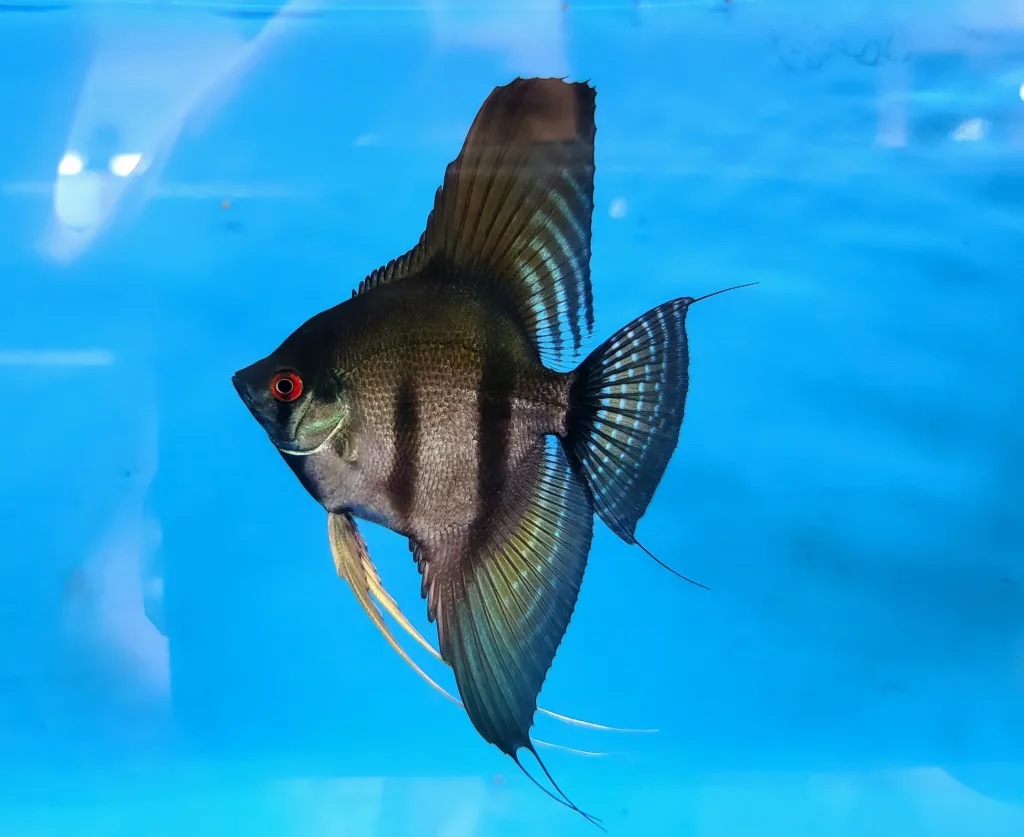Black lace angelfish, scientifically known as Pterophyllum scalare, is a beautiful and popular aquarium fish species. They are a variation of the common angelfish (Pterophyllum scalare) and are prized for their striking black and white coloration and distinctive fin patterning. These angelfish have a predominantly dark body with contrasting, intricate lace-like patterns that resemble delicate, black lace on their fins. The combination of their elegant appearance and graceful swimming behavior makes them a sought-after choice for many aquarium enthusiasts.
Origin of Black Lace Angelfish
Black lace angelfish have an interesting origin that plays a role in their unique characteristics and care requirements.
Black lace angelfish are a selectively bred variant of the wild angelfish (Pterophyllum scalare), which are native to the tropical freshwater rivers of South America. They are primarily found in the Amazon River basin, including regions of Brazil, Peru, and Colombia. In the wild, angelfish are known for their laterally compressed bodies, long, triangular dorsal and anal fins, and their silvery coloration with vertical black stripes.
Appearance and Size of Black Lace Angelfish
Black lace angelfish are known for their exquisite appearance and graceful demeanor, making them a stunning addition to any aquarium. Let’s delve into their distinctive characteristics:
Appearance
Black lace angelfish are prized for their striking and intricate coloration, which distinguishes them from other angelfish variants. Their key features include:
- Black and White Coloration: These angelfish exhibit a predominantly black body with white or silver stripes and lace-like patterns on their fins. The contrast between the dark body and the delicate white patterns creates a captivating and elegant appearance.
- Fin Patterns: One of the most striking features of black lace angelfish is the elaborate patterns on their dorsal and anal fins. These patterns resemble lace or intricate filigree, giving them their name.
- Triangular Shape: Like all angelfish, they have a laterally compressed, triangular body shape, which adds to their graceful presence in the aquarium.
- Long Fins: Black lace angelfish have long, flowing fins, which add to their beauty and elegance. However, aquarists should be cautious, as these fins are vulnerable to damage.
Size
Black lace angelfish, like their wild counterparts, can vary in size depending on their age and care. On average, they reach a size of about 6 to 8 inches (15 to 20 centimeters) when fully grown. It’s essential to note that their size can be influenced by the tank they are kept in, their diet, and overall care.
Black Lace Angelfish Care Guide
Black lace angelfish, with their captivating appearance and graceful demeanor, make wonderful additions to home aquariums. To ensure the health and well-being of these beautiful fish, it’s crucial to understand their care requirements. This guide covers three essential aspects of black lace angelfish care:
Setting Up the Perfect Aquarium
Tank Size
For a pair of black lace angelfish, it’s recommended to have a tank that is at least 20-30 gallons in size. A larger tank provides more swimming space and helps maintain stable water conditions.
Water Parameters
- Temperature: Maintain a water temperature between 78-82°F (25-28°C).
- pH Level: Keep the pH in the slightly acidic to neutral range, ideally between 6.5-7.0.
- Water Hardness: Aim for soft to moderately hard water, with a dGH (degree of General Hardness) of 5-12.
Filtration and Aeration
Good filtration is essential for keeping the water clean and free from ammonia and nitrite buildup. Additionally, gentle aeration can provide the necessary oxygen for your angelfish.
Substrate and Decor
Black lace angelfish feel more comfortable in well-planted tanks with soft, fine-gravel substrate. Use live or artificial plants to create hiding spots and recreate their natural habitat.
Feeding and Diet
Black lace angelfish are omnivores, and their diet should be varied to ensure their nutritional needs are met. Offer a mix of the following foods:
- High-quality flake or pellet food designed for angelfish.
- Frozen or live foods like brine shrimp, bloodworms, and daphnia.
- Fresh vegetables, such as blanched spinach or cucumber, can be a healthy addition.
Feed them 2-3 times a day, only what they can consume in a few minutes, to prevent overfeeding and maintain water quality.
Common Health Issues and Solutions
Potential Health Issues
Angelfish can be susceptible to common aquarium diseases such as:
- Ich (White Spot Disease): Caused by a protozoan parasite, it presents as white cysts on the fish’s body.
- Fin Rot: Bacterial infection leading to fin damage.
- Hexamita (Hole-in-the-Head Disease): A parasitic infection that can lead to lesions on the head and body.
Breeding Black Lace Angelfish
Breeding black lace angelfish can be a rewarding experience for aquarium enthusiasts. These fish exhibit unique courtship and parenting behaviors. Here’s a guide on how to breed black lace angelfish:
Selecting Breeding Pairs
- Mature Age: Ensure that your angelfish are sexually mature, typically around 10-12 months old. Mature fish are more likely to exhibit breeding behaviors.
- Pair Formation: Black lace angelfish are monogamous and form pairs. Observe their interactions in the community tank to identify potential pairs. They may display courtship behavior by swimming together and cleaning a chosen breeding site.
- Isolation: Once a pair forms, consider isolating them in a separate breeding tank. This will reduce the chances of aggression from other tankmates and protect the eggs and fry.
Breeding Tank Setup
- Tank Size: A breeding tank of 20-30 gallons is usually sufficient. Ensure it is well-maintained with stable water parameters.
- Substrate and Shelter: Provide a flat, vertical surface for them to lay eggs. Angelfish prefer to lay their eggs on clean, vertical surfaces like broad plant leaves, PVC pipes, or a slate. You can use a spawning cone or a piece of flat slate as a substrate.
- Water Conditions: Maintain water conditions as follows:
- Temperature: Around 80-82°F (27-28°C).
- pH: Slightly acidic to neutral, between 6.5-7.0.
- Water Hardness: Soft to moderately hard, dGH of 5-12.
- Filtration: Use a sponge filter or gentle filtration to prevent strong currents that can harm the eggs and fry.
Courtship and Spawning
- Courtship: Once a pair has formed, they will engage in courtship behaviors, such as swimming together, cleaning their chosen spawning site, and displaying vivid colors.
- Egg Laying: The female will lay eggs on the chosen substrate, and the male will follow to fertilize them. Typically, the eggs are adhesive and stick to the chosen surface.
- Parental Care: The parents will guard and fan the eggs to ensure proper oxygenation. It’s crucial to leave the parents with the eggs and avoid disturbing them during this time.
Raising Fry
- Hatching: The eggs will hatch in about 48-72 hours, depending on water temperature.
- Free-Swimming Fry: After hatching, the fry will become free-swimming. At this stage, they can be fed infusoria or commercially available liquid fry food.
- Transition to Larger Food: As the fry grow, gradually introduce newly hatched brine shrimp and powdered fry food to their diet.
- Separation: Once the fry become larger and more independent, they can be separated from the parents or placed in a larger grow-out tank.
Remember that successful breeding may take time and patience. Not all breeding attempts are guaranteed to be successful, so be prepared for multiple attempts if necessary. Additionally, maintaining optimal water quality and a stress-free environment is essential for successful breeding.
Where to Buy and Average Price of Black Lace Angelfish
Black lace angelfish are popular among aquarium enthusiasts, and they can be found in various places. When considering where to buy them, it’s important to choose a reputable source to ensure the health and quality of the fish. Here are some options for purchasing black lace angelfish, along with the average price range:
Local Fish Stores (LFS)
Local fish stores are a common source for purchasing black lace angelfish. You can visit LFS in your area, where you can physically inspect the fish before purchase. Prices at local stores can vary, but you can generally expect to pay anywhere from $10 to $20 per fish, depending on the size and the quality of the angelfish.
Online Retailers
Numerous online retailers and specialty websites offer a wide selection of angelfish, including black lace variants. Shopping online provides access to a broader range of choices and allows you to compare prices. The average price for black lace angelfish online ranges from $10 to $25 per fish, excluding shipping costs.
Aquarium Shows and Auctions
Many aquarium clubs and hobbyist organizations organize events like auctions and shows where you can purchase fish directly from breeders and fellow enthusiasts. These events may offer competitive prices, and you might find unique strains and high-quality fish.
Breeders
Contacting breeders who specialize in angelfish breeding is another excellent option. You can find breeders both locally and online. Purchasing from a breeder can provide assurance of the fish’s lineage and health. Prices from breeders can vary but may be higher due to the quality of the fish, ranging from $20 to $50 or more per fish.
It’s essential to consider the reputation and reviews of the seller when making your purchase. Ensure the angelfish you choose appear healthy, have vibrant colors, and show no signs of disease or stress. Quarantine new fish before adding them to your main tank to prevent the spread of potential diseases.
The prices mentioned here are approximate averages and can vary based on factors like the fish’s size, age, and the rarity of the strain. Always check with specific sellers for their current pricing.










